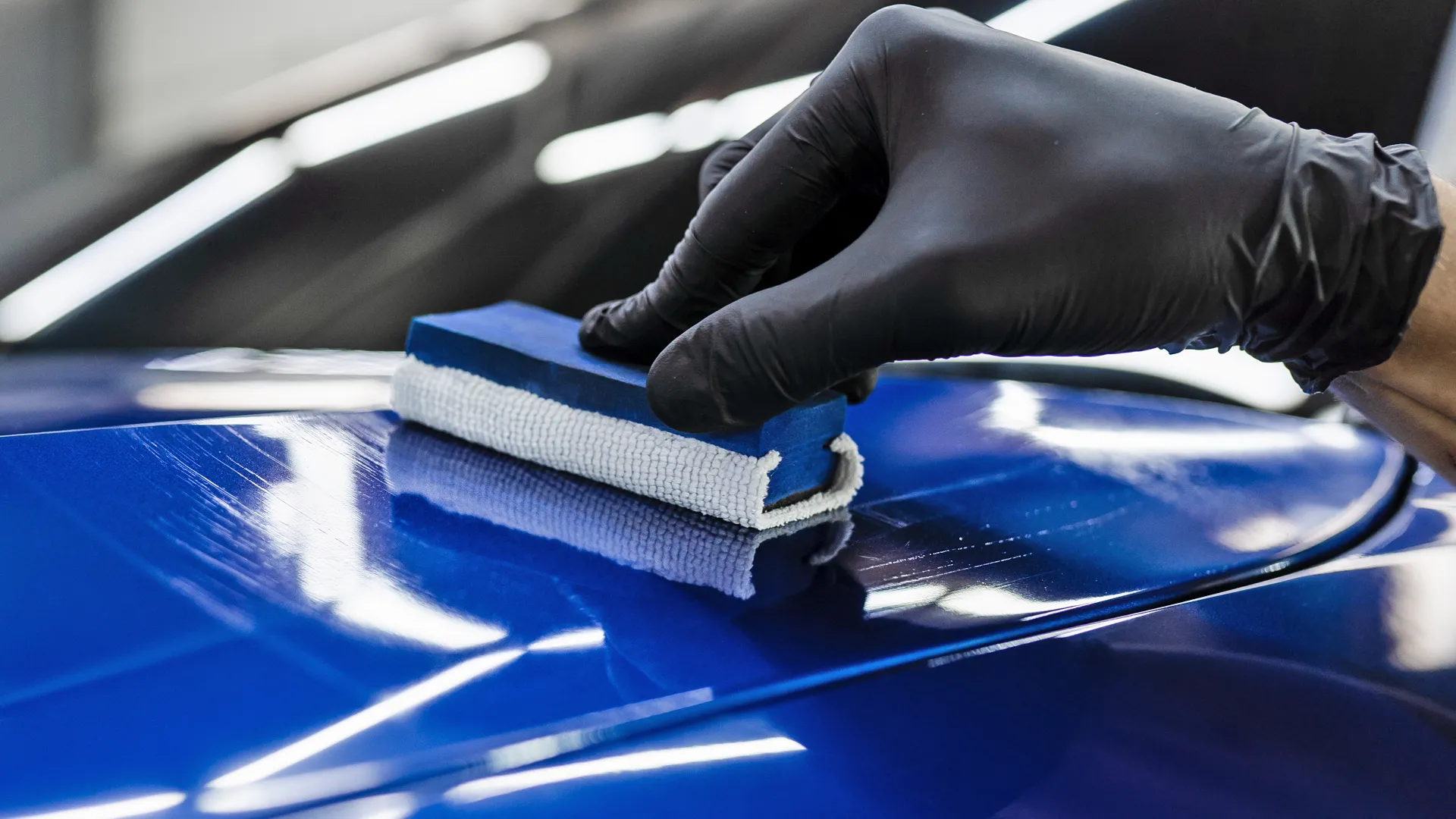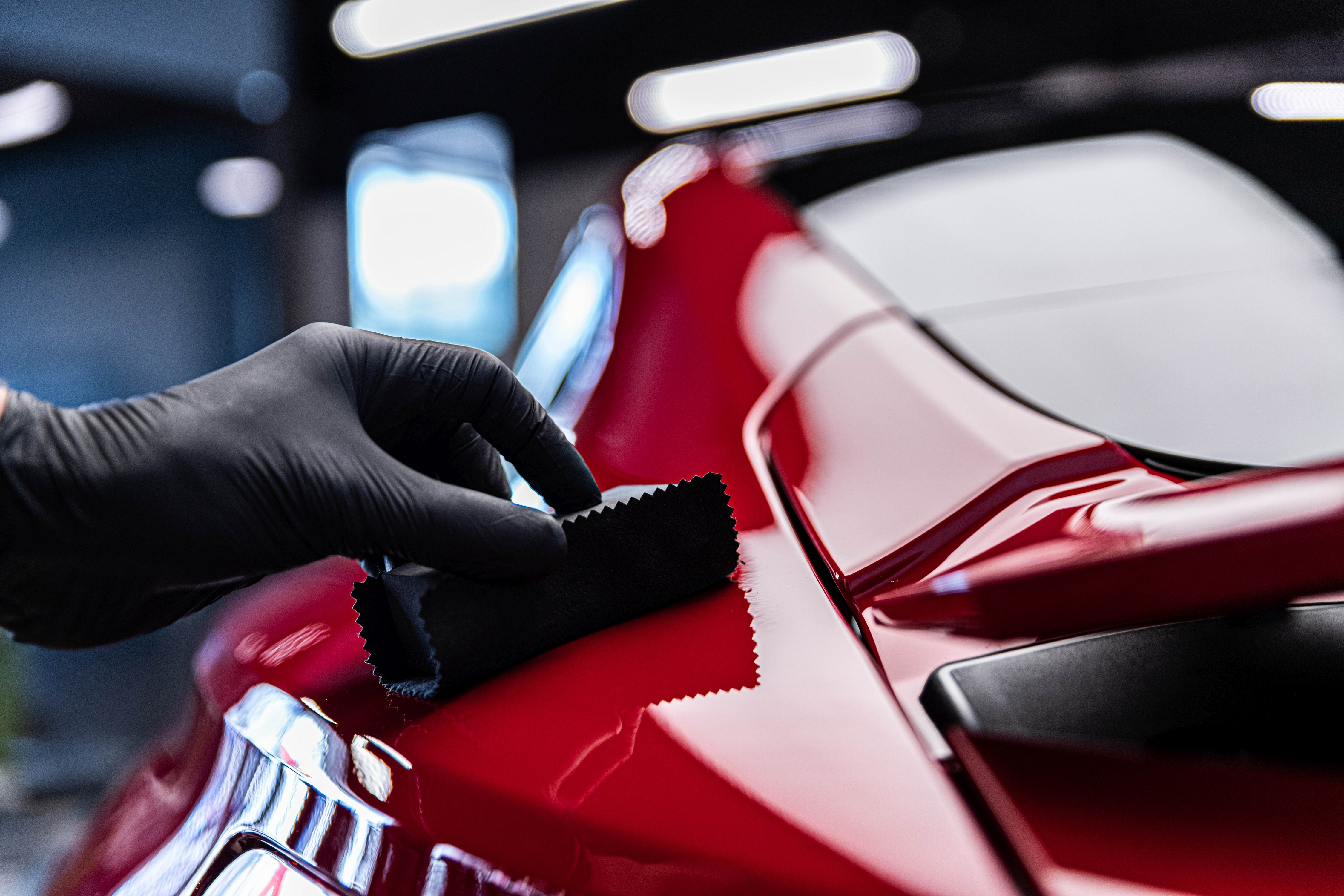Checking out the Science Behind Car Ceramic Coating and Its Protective Residences
The scientific research of car ceramic coating presents a fascinating research in advanced vehicle defense. Composed largely of silicon dioxide and polymers, these finishings form a durable bond with vehicle paint. This interaction improves resilience versus ecological hazards while supplying hydrophobic benefits. However, the intricacies of exactly how these finishings work and their lasting advantages stay much less comprehended. Unpacking these information reveals why ceramic coverings are ending up being a preferred choice for car treatment
What Is Ceramic Coating?
Ceramic coating is a liquid polymer that chemically bonds to the surface area of an automobile's paint. This advanced safety layer enhances longevity and uses remarkable resistance to ecological elements. Unlike typical wax or sealants, which supply momentary protection, ceramic coverings produce a lasting guard that can endure rough problems such as UV rays, acidic impurities, and extreme weather condition. When used appropriately, the coating creates a hydrophobic surface, creating water to bead and slide off, which aids in preserving the automobile's tidiness. Furthermore, it provides enhanced gloss and deepness to the paint, making the lorry appear more polished and vibrant. The application procedure commonly involves comprehensive surface preparation, consisting of cleansing and polishing, to assure peak bonding. Consequently, ceramic finishings are becoming significantly prominent amongst car lovers and those seeking to secure their investments, promising to maintain the vehicle's aesthetic appeal while lowering the regularity of upkeep.
The Make-up of Ceramic Coatings
The detailed solution of ceramic finishes mainly is composed of silicon dioxide (SiO2), which is originated from all-natural resources like quartz and sand. This vital element supplies the foundation for the coating's toughness and safety top qualities. Along with SiO2, ceramic finishes frequently consist of numerous polymers and additives that boost attachment, adaptability, and resistance to ecological elements. These substances work synergistically to produce a durable barrier versus impurities such as dust, chemicals, and UV rays.Furthermore, some formulations include titanium dioxide (TiO2) or various other nanomaterials, which can augment the coating's hydrophobic residential or commercial properties, causing improved water repellency. The precise make-up can differ considerably among manufacturers, affecting performance and durability. Ultimately, the mix of these elements finishes in a protective layer that not only improves the aesthetic appeal of vehicles but additionally serves to lengthen their life expectancy by protecting the surface from possible damage.
Exactly How Ceramic Coatings Job
Comprehending exactly how ceramic coverings work involves discovering their chemical make-up, which adds to their protective top qualities. The application process is crucial for attaining excellent results, while longevity and longevity elements establish the coating's performance with time. Together, these aspects highlight the benefits and efficiency of ceramic finishes for vehicle protection.
Chemical Composition Explained
While lots of car owners seek durable protection for their lorries, the chemical structure of ceramic coverings plays an essential role in their effectiveness. These finishes mainly contain silicon dioxide (SiO2), which is originated from natural minerals. This substance creates a strong bond with the lorry's paint, producing a durable, safety layer. Furthermore, numerous ceramic layers consist of titanium dioxide (TiO2), enhancing their hydrophobic buildings and resistance to UV rays. The existence of polysiloxanes can additionally boost adaptability and longevity. With each other, these aspects add to the coating's capacity to ward off water, dust, and impurities, while also supplying a high-gloss surface. Comprehending this chemical structure helps car proprietors value the robust security used by ceramic finishes.
Application Process Overview
Using ceramic layers includes a thorough process that ensures suitable bonding and security for the vehicle's surface area. At first, thorough cleansing and purification of the car's exterior are carried out to remove dirt, grime, and previous waxes. This action confirms that the surface is without pollutants that could prevent adhesion. Following this, the paint is typically brightened to boost quality and remove any type of imperfections. When prepared, the ceramic coating is applied in small areas using an applicator pad, enabling consistent protection. The coating is after that entrusted to cure, forming a strong chemical bond look what i found with the surface. Proper treating times and conditions are important, as they verify the coating accomplishes its maximum effectiveness and safety top qualities.
Long Life and Longevity Aspects
Ceramic finishings are created to offer resilient defense through their innovative chemical make-up, which produces a durable barrier versus ecological impurities. The resilience of these finishes is influenced by factors such as the density of the application, the quality of the product, and the problems under which the automobile is revealed. Top notch ceramic layers can last a number of years, standing up to scrapes, UV rays, and chemical discolorations. Proper maintenance, including regular cleaning and periodic reapplication, can further boost long life. Furthermore, environmental variables like environment and direct exposure to contaminants can affect the life expectancy of the coating. On the whole, when applied and preserved appropriately, ceramic finishings offer exceptional sturdiness, making them a prominent selection for car enthusiasts looking for to maintain their vehicle's look.
Hydrophobic Features and Water Repellency
Hydrophobic residential properties are a hallmark of top quality car ceramic coatings, significantly enhancing the lorry's surface performance. These finishes produce a molecular bond with the car's paint, leading to a surface that pushes back water properly. When water enters into contact with a ceramic-coated surface, it grains up and rolls off, minimizing the amount of liquid that continues to be on the paint. This actions not just adds to a cosmetically pleasing look however also minimizes the build-up of pollutants such as dirt, grime, and roadway salts.The enhanced water repellency brings about less complicated cleansing and maintenance, as less initiative is called additional resources for to get rid of unwanted materials. On top of that, the hydrophobic nature of ceramic finishings aids in preventing water places, which can mar the finish of uncoated surfaces. In general, the unification of hydrophobic homes in ceramic coatings plays an essential role in keeping the automobile's beautiful appearance while streamlining upkeep.
Protection Against Scratches and UV Damages
Car ceramic coatings provide significant security against scratches and UV damages. The scratch resistance device develops a resilient layer that soaks up influences, while the UV securing benefits assist maintain the lorry's paint integrity with time. Together, these attributes contribute to a longer-lasting and visually appealing finish.
Scratch Resistance Device
Using advanced innovation, ceramic coverings give a robust shield against scratches and UV damages, improving the longevity and appearance of automobile surfaces. The scratch resistance mechanism of these layers is connected to their one-of-a-kind molecular structure, which creates a durable bond with the automobile's paint. This bond develops a hard, protective layer that can absorb impacts and stand up to abrasions. In addition, the smooth surface of the coating lowers rubbing, making it hard for impurities to stick and create scratches. The chemical make-up of ceramic finishings usually includes nanoparticles that enhance the safety layer, additional enhancing its strength. Lorries treated with ceramic finishes exhibit considerably boosted scratch resistance contrasted to conventional wax or sealers, making sure an excellent coating over time.
UV Protecting Benefits
The safety high qualities of ceramic coverings extend past scrape resistance to include significant UV shielding benefits. These finishes develop a durable barrier that shows unsafe ultraviolet rays, protecting the car's paint and underlying products. Long term direct exposure to UV radiation can result in fading, oxidation, and wear and tear of the paint surface. By integrating ceramic finishings, vehicle proprietors can properly alleviate these dangers, protecting the visual allure and honesty of their cars and trucks. Additionally, the UV obstructing properties add to boosted durability, reducing the frequency of painting and upkeep. Eventually, the combination of ceramic layers offers a comprehensive service for protecting lorries from the damaging effects of sun direct exposure, making sure continue reading this a continual, vibrant appearance gradually.
The Long life and Upkeep of Ceramic Coatings

Regularly Asked Inquiries
Can Porcelain Coating Be Applied to Any Type Of Kind Of Lorry?
Ceramic coating can be related to various types of lorries, consisting of cars and trucks, vehicles, and motorbikes. Nevertheless, surface prep work and compatibility with details products are vital for ideal bond and efficiency of the coating.
Exactly How Much Does Ceramic Coating Commonly Price?
Ceramic coating normally sets you back in between $500 and $2,000, relying on aspects such as automobile dimension, coating top quality, and specialist application. The investment can provide lasting protection and boost the automobile's appearance over time.

Is Professional Application Necessary for Best Outcomes?
The need of expert application commonly depends upon preferred results. Experts commonly ensure correct surface area preparation and application techniques, leading to ideal bonding and long life of the coating, which might be challenging for inexperienced people to achieve.
Can Porcelain Coatings Be Removed or Fixed?
Ceramic finishings can be removed or fixed, though the procedure may call for details solvents or methods - Ceramic Coating Newark. Proper elimination is necessary to prevent damages to the underlying surface area, emphasizing the relevance of specialist help for excellent results
Exactly How Does Ceramic Coating Contrast to Conventional Wax?
The contrast between ceramic coating and conventional wax discloses that ceramic finishings offer remarkable sturdiness, enhanced security versus ecological contaminants, and longer-lasting luster, while wax calls for a lot more frequent application and offers much less total resistance to damages.